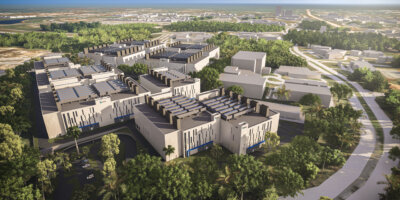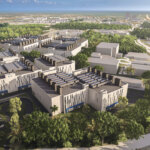
Here’s how generative AI is affecting data centers
- The unnoticed consequence of generative AI is the rising data center demand as it embeds deeper into daily life.
- Investors should note the ongoing growth in the APAC data center industry, hinting at numerous participation opportunities.
As the AI goldrush, spearheaded by technologies like Open AI’s ChatGPT and Google’s Bard, gains momentum, its growing prevalence is driving demand in data centers, with research projecting the generative AI market to reach US$126.5 billion by 2031, expanding at a CAGR of 32% from 2022 to 2031.
What’s often overlooked is generative AI’s impact on data center demand – as society integrates such technology more deeply into everyday life, the demand for computing power in data centers escalates. The server computer density that AI requires also generates significant heat, presenting energy efficiency and sustainability challenges. On the other hand, AI and machine learning have the potential to boost data center performance and facilitate operation-based technologies like liquid cooling.
Tech Wire Asia recently interviewed Chris Street, Managing Director of Data Centres, Asia Pacific, JLL, discussing the dual-edged sword of generative AI within data centers.
The impact of AI on data centers
AI is a primary factor driving demand for data centers, alongside other aspects such as increasing reliance on digital entertainment, including social media, online gaming, and streaming services. Moreover, government services, healthcare, and financial sectors moving online also demand robust digital infrastructure.
Street says, “From a technical perspective, we are seeing increased power densities for IT systems that support AI applications. The surge in computing power brings challenges to existing data centers, especially older facilities not designed for these types of applications. This situation makes the move to cloud services imperative for many organizations, though they must also decide how to manage existing infrastructure and facilities.”

Chris Street, Managing Director of Data Centres, Asia Pacific, JLL
According to Street, some facilities can be repurposed, while others might need considerable effort for upgrading, which may not be worth it. Alternatively, these facilities could introduce modern technologies such as immersion or liquid cooling to address high-density issues.
Given the massive resources and computing power required for AI development, there are concerns about its impact on the number of companies able to make breakthroughs in the field.
Street observes that firms feel pressure to scale enough to lower compute or storage costs, as the compute required can significantly impact capex investment. However, firms with smaller requirements have several options to deploy these workloads, including using private and public cloud infrastructure to handle high-compute AI workloads.
The investment landscape in the data center industry
Investors can anticipate continued growth and development in the data center industry across the Asia Pacific (APAC) region, offering multiple opportunities for industry participation.
Street notes, “We continue to see two primary models. The first is a more traditional real estate focused investment that views facilities as real assets and partners with a service provider, such as a cloud or colocation provider, as the tenant. The second model involves more risk and enters a joint venture with the operator to invest in the operating company.”
Looking at the challenges the data center industry will face this year, Street mentions significant issues within the supply chain, both from manufacturing items like generators and chillers and from an infrastructure standpoint like utilities, including electricity and water. Constraints due to lacking these utilities in major metropolitan markets put pressure on markets across Asia like Tokyo, Singapore, Shanghai, and Seoul.
He also highlights another significant challenge: sustainable developments. The industry must ensure efficiency and sustainability from the supply chain to the services delivered to end users. Greater disclosure and transparency will enable a robust discussion on how the digital infrastructure industry can support broader sustainability goals.
While the data center industry has been increasing its energy efficiency operationally and pushing to become sustainable, the challenge is significant given the amount of energy used. However, this is an area that operators, investors, and end users are prioritizing as an important criterion when selecting a service provider.
JLL’s role in Southeast Asia’s data center landscape
Street emphasizes the need for the industry to collaborate with other technology firms, government agencies, regulators, and local communities to drive sustainability efforts forward.
As for JLL’s role in the Southeast Asian data center industry, it leverages significant resources across the region to support clients throughout the entire lifecycle, from data center investment and development to operations. JLL works with investors and service providers to develop market investment strategies and with operators to design, build, and operate facilities.
“In addition, we do a significant amount of work with both end users and operators on the sustainability front. This starts with evaluating how their data center strategy aligns with the overall corporate goals and objectives, as well as operational strategies and audits of third-party service providers,” Street concludes.
READ MORE
- 3 Steps to Successfully Automate Copilot for Microsoft 365 Implementation
- Trustworthy AI – the Promise of Enterprise-Friendly Generative Machine Learning with Dell and NVIDIA
- Strategies for Democratizing GenAI
- The criticality of endpoint management in cybersecurity and operations
- Ethical AI: The renewed importance of safeguarding data and customer privacy in Generative AI applications


